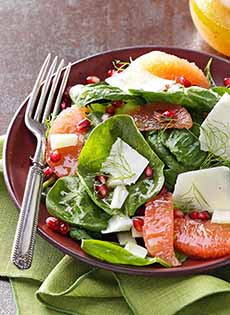|
|
If you never enjoyed the tartness of white and pink grapefruits, give red grapefruit a chance. Not only is it a sweeter, lush flavor, but its the perfect color to perk up gray winter days, or to accent Valentines Day meals. Red grapefruit was discovered as a mutation growing on a pink grapefruit tree. After years of breeding, the Ruby Red cultivar was released to market. Different growers established brand names: Flame, Rio Red, Rio Star, Ruby-Sweet, Star Ruby, Sweet Scarletts, TexaSweet and others. Different brands can have different shades of flesh. For example, Floridas Ruby Reds are deep pink, while Flame grapefruits have deep red flesh. One of the best ways to eat grapefruit is to simply peel it and eat it like an orange. One of the best ways to use the peel is to make candied grapefruit peel (one of our favorite confections and garnishes!). Heres the recipe. But every meal, snack, and drink offers a chance to indulge in red grapefruit:
America is the worlds largest consumer of grapefruit, with large commercial groves in Arizona, California, Florida and Texas. But the grapefruits ancestor, the pummelo (also pomelo or shaddock), comes from far awayits native to Malaysia and Indonesia. Its the largest citrus fruit. Pummelo seeds were brought from the East Indies to the West Indies in 1693 by an English ship commander. The grapefruit may have been a horticultural accident or a deliberate hybridization between the pummelo and the orange. The original grapefruit was about the size of an orange. It was originally called both forbidden fruit, and the smaller shaddock, after Captain Shaddock, who brought the seeds. Grapefruit Comes To The U.S. The grapefruit arrived in the U.S. in 1823, but it was not immediately popular; the thick skin was unusual and an impediment. But the tree thrived, and its name evolved in English based on how it grows: in grapelike clusters. In 1870, the large, golden clusters on a tree he passed attracted John A. MacDonald, who lived in Orange County, Florida. MacDonald established the first grapefruit nursery. Floridas first shipment of grapefruits to New York and Philadelphia, in 1885, generated interest and helped create the commercial grapefruit industry. By the late 1800s, grapefruit trees were being cultivated in the southern part of Texas; by 1910 grapefruit had succeeded in the Rio Grande Valley of Texas, as well as in Arizona and California. The pink grapefruit and other varieties were developed.
|
|
|
From the 1930s through the 1950s, a grapefruit half was a breakfast favorite, topped with a spoonful of sugar or honey, and sometimes a dash of cinnamon, nutmeg, or cloves. Sometimes, it was lightly broiled. The grapefruit sections were loosened with a special knife that has a serrated, curved blade. Other homes had special grapefruit spoons: teaspoons with a serrated front edge. If you have some from Grandma or Great-Grandma, its time to dig them out. Otherwise, both grapefruit knives and grapefruit spoons are inexpensive. Heres more on how people used grapefruit at home, including adding the juice to vinegar. The first grapefruits were white. Pink grapefruit, a mutation, was first discovered in 1906 in the groves of the Atwood Grapefruit Company in Manatee County, Florida. One day, a grove foreman peeled a grapefruit with the intention of eating it, and discovered that the fruit inside was pink! A local nurseryman was able to propagate the pink fruit, and it met with big success: In addition to a more pleasing color, the flesh tended to be sweeter. Thank Goodness For Mutations Another mutation gave us red grapefruit, which was originally discovered growing on a pink grapefruit tree in Texas. It was patented as Ruby Red grapefruit in 1929. Red grapefruit is known in agriculture as a limb sport, a mutation of one limb (branch) that has different fruit characteristics than the rest of the tree. A hit from the start, sweeter with alluring rosy red flesh, Ruby Reds are marketed under different names: Flame, Rio Red, Rio Star, Ruby-Sweet, Star Ruby, Sweet Scarletts, TexaSweet and others. While consumers call these different red grapefruits varieties, botanically its more accurate to call them different selections because they are all derived from one another as descendants of the original Ruby Reds. Each has different small attributes, tailored to succeed in different climates and soils. Otherwise stated, all of the different deep red grapefruits grown around the worldRio Red in Texas, Star Ruby in South Africa, Flame in Florida, etc.are not botanically different, but have been adapted to the the climate and soil in each region. Red and pink grapefruits contain lycopene, a phytochemical (antioxidant) found in tomatoes and some other red fruits and vegetables such as papaya, red carrots and watermelon. Red grapefruits have a greater concentration than pink grapefruits. Why are red grapefruits sweeter? Its all in the weather. Sweet Scarletts, for example, are grown in the Rio Grande Valley of Texas, where hot days, cool nights and the unique terroir merge to create the ideal grapefruit. Most red grapefruits are grown in Texas, since the The Texas climate produces the sweetest red grapefruits. |
||
TIP OF THE DAY: Red Grapefruit For Valentines Day
← Older Post Newer Post →







